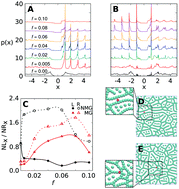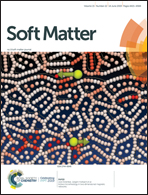Active microrheology in two-dimensional magnetic networks†
Abstract
We study active microrheology in two-dimensional (2D) magnetic networks. To this end, we use Langevin dynamics computer simulations where single non-magnetic or magnetic tracer particles are pulled through the network structures via a constant force f. Structural changes in the network around the pulled tracer particle are characterized in terms of pair correlation functions. These functions indicate that the non-magnetic tracer particles tend to strongly affect the network structure leading to the formation of channels at sufficiently high forces, while the magnetic tracer particles modify the network structure only slightly. At zero pulling force, f = 0, both non-magnetic and magnetic tracer particles are localized, i.e. they do not show diffusive behavior in the long-time limit. Nevertheless, the friction coefficient, as obtained from the steady-state velocity of the tracer particles, seems to indicate a linear-response regime at small values of f. Beyond the latter linear response regime, the diffusion dynamics of the tracer particles are anisotropic with superdiffusive behavior in force direction. This transport anomaly is investigated via van Hove correlation functions and residence time distributions.



 Please wait while we load your content...
Please wait while we load your content...